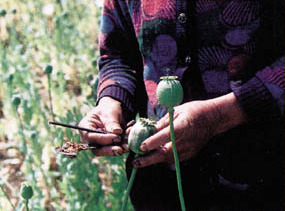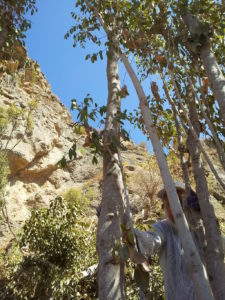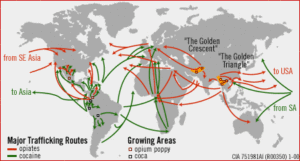Resources for Travel in France

Shawn Smallman, 2017

Shawn Smallman, 2017

I’ve been teaching a course on the Global Drug Trade this year, and my class recently covered the opioid crisis, including the emerging drugs of fentanyl and carfentanyl. If you haven’t heard of these drugs before, you might want to read German Lopez’s Vox article “How an elephant tranquilizer became the latest deadly drug in the opioid epidemic.” While the epidemic exists in the United States, these drugs are causing havoc in British Columbia, Canada. What is distinct about these drugs is that they are not only dangerous to the user, but also first responders. The crisis has been so serious that it has caused people to rethink how we deal with illegal drugs in a profound manner.
In my class there was a great deal of discussion of whether the broader opioid epidemic is being covered differently in the media because many people using these drugs are middle class, white and older. They are also distinct, my students noted, in that most people who become addicted do so because they received a prescription for the drugs legally. There is no question but that major corporations have pushed these drugs, as this wonderful John Oliver piece describes. The epidemic has deepened, because when people have difficulty accessing legal opioids they have turned to heroin. …

One of my students shared a graph from Wikipedia titled “Rational harm assessment of drugs radar plot.” The caption stated: “Addiction experts in psychiatry, chemistry, pharmacology, forensic science, epidemiology, and the police and legal services engaged in delphic analysis regarding 20 popular recreational drugs. Barbiturates were ranked 5th in dependence, 3rd in physical harm, and 4th in social harm.” Much of the information on the graph is unsurprising, such as the fact that experts widely agreed that heroin is the most destructive drug. It’s clear, however, that the legal consequences of drug use bear little relation to the harm that they may do. Alcohol, for example, is perceived to be far more harmful than Khat, while barbiturates are judged to be more dangerous than cannabis. Of course, all these drugs also have some form of harm associated with them, and some have devastated individuals and communities. Still, this graph might be a useful tool to frame public policy decisions related to the drug trade.
Shawn Smallman, 2017
An outstanding INTL major named Hannah Latimer-Snell is working this fall on a project through IE3 Global Internships and Portland State University.
This is a self-arranged internship because Hannah found a small non-profit film company called Lime Soda Films in Chennai, India that she wanted to work with. She then “pitched” the idea to IE3 so she could receive academic credit. She will be in Chennai for 4 months working on a documentary about workplace harassment against women.
Here is what Hannah shared with me about this project:
“Here is a link to our website where you can find out trailer and more information about our film and how to get involved: http://butwhatwasshewearing.wordpress.com
Right now our team is made up of three independent filmmakers from India, Germany and the United States of America. Our project is a small budget film but tackles a large and international issue: workplace harassment. Our goal for the film is to expose the systems that continue to perpetuate gender inequality and create the space for women to share their stories.”
The link for the “Go fund me” campaign is at the bottom of the webpage if you are interested in contributing.
Shawn Smallman, 2017

The Lost City of Z is now a movie; you can see the trailer here. The movie’s concept has received a scathing review by John Hemming, who is perhaps the most famous living Amazonian explorer. Hemming’s own book, Red Gold, tells the story how Brazil’s indigenous peoples fought against Portuguese exploitation and conquest over the course of centuries. For Hemming, Fawcett was a dilettante with strange religious ideals, who lost his life due to his own lack of knowledge about the Amazon.
The legend of the Lost City of Z is based upon a document now held in Rio de Janeiro’s national library, which supposedly was written in 1743; the document claims to tell the history of a group of bandeirantes (explorers and slavers) who found a lost city in the interior. As Hemming points out, these men were almost always illiterate, so the fact that such a document exists is surprising in and of itself. It was also the case that other explorers had been working in Amazonia for centuries by the time Fawcett disappeared, with no other discoveries of such a city. …
Unlike most of my posts, I’ve written this piece mainly for department chairs and program directors in International and Global Studies. This post is unlikely to be of much interest to anyone else, as it doesn’t deal with issues that most of us are passionate about in the field, but rather the pragmatics of running a program. I’ve been a department chair for three terms, and a dean for four years. As at many state-based institutions, our university is moving towards performance based budgeting, which means that there is intense attention to student credit hours (SCH), which is sometimes called the “coin of the realm.” For this reason, I’ve invested a lot of time in thinking about enrollment trends and how to draw more students into classes in International and Global Studies. Here are some thoughts on this issue, which I believe apply to our program, although I don’t know if these observations will be true at other institutions. …
I love storyboards, which combine audio, video photos and maps to cover a topic in an interactive manner. The New York Times has an outstanding storyboard on Antarctica, which would be a great resource for an introductory class. I particularly liked the beautiful maps which showed the direction of ice flow by flowing colored lines, which became animated when clicked upon. In part two, another map reveals how much of Antarctica is actually ice, through a map that allows the viewer to strip away the ice cover to reveals the mountains and bedrock underneath. What had seemed to be a unitary continent is revealed to be a world of islands and peninsulas. The second immersive video, in which they fly past a six mile long iceberg, is also striking. Through the window you can see dramatic imagery, but when you swivel the camera back to the pilots they seem quite bored. The three part series ends with four videos, which are narrated. The first is covers a dive underneath the ice, which has spectacular images of an otherworldly environment, and will allow you to briefly escape your workaday world.
Shawn Smallman, 2017

In 2013 the Oil Drum closed, North Dakota was booming, and the United States was moving towards energy self-sufficiency. Fracking had changed the global energy landscape. By 2016 oil prices were in a steep decline, that they have only recently begun to recover from. Coal was waning because of the low cost of gas,
In 2017 Toshiba’s Westinghouse has entered bankruptcy because of the high cost of building new nuclear reactors in the American South. It’s not at all clear that it is technically possible to stop the radioactive contamination of water in Fukushima, at any cost or within any timeframe. There are grave doubts that the Japanese government is being forthright about this challenge. With the exception of China and France (and to a much lesser extent, Great Britain) the nuclear industry is in decline.
Tesla is now worth more than GM (although critics say that its valuation is a bubble), and the company is diversifying into batteries. The price of wind power is now competitive with many other sources, and the offshore wind industry has finally begun to produce power in the United States. Perhaps even more important, the price of solar energy is falling at a staggering rate. In the long term, technology breakthroughs are promising to create solar panels that are far more efficient than the current technology, which is approaching its theoretical limit. If solar follows the same economic trajectory as wind power, the changes within our energy infrastructure will be profound. …

During the last U.S. presidential election campaign Wikileaks drew extensive news coverage, as it released data from the Democratic National Committee shortly before the election took place. In March Wikileaks released a massive amount of data regarding CIA’s espionage capabilities. But how does Wikileaks fact-check its data? Can you trust that what it posts is real and not a hoax? If you’ve ever wondered about this, then you might want to listen the BBC World Service podcast, the Inquiry, which has an episode titled “Can you believe what you read on Wikileaks?” You can also find the episode on Stitcher here. What’s fascinating about this podcast is that the journalist interviewed disillusioned members of Wikileaks itself. The bottom line is that the data released to date has been very reliable. At the same time, Assange has nearly total control over what is released, and so his agenda determines Wikileak’s decisions.
There has recently been a great deal of discussion regarding whether Wikileaks has released information obtained from the Russian state. Assange has denied this. Still, it’s also perfectly possible that the Russian state may be running a false-flag operation -an idea as old as espionage itself- in order to pass on information to Wikileaks. More important, however, is the fact that Wikileaks is very much defined by the decisions of a single individual. The podcast discusses Assange’s history, motivations and relationships, to try put Wikileaks into context as a political actor.
Shawn Smallman

United Nations Office on Drugs and Crime, World Drug Report, 2016.
U.S. Department of State, 2017 International Narcotics Control Strategy Report. This is a two volume document, which has statistical information embedded into it in the form of charts and tables.
Do you know of another good source of statistics on the Global Drug Trade? Please let me know at drss@pdx.edu.
Shawn Smallman, Portland State University